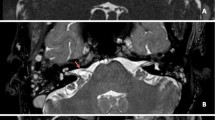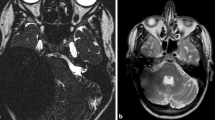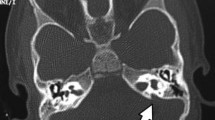Abstract
Magnetic resonance imaging (MRI) is recognised as the “Gold Standard” investigation for symptoms pertaining to the inner ear and detection of retro-cochlear pathology. There is still no accurate clinical predictor for cerebellopontine angle lesions and increasingly more normal scans are being performed. With constantly increasing demands on ENT outpatient clinics, our aim was to investigate whether all patients referred for MRI of their internal auditory meatus (IAM) require follow-up in ENT clinics. A retrospective study was carried out in a tertiary referral centre referring patients for MRI IAM from ENT clinics and neurotology clinics on 153 patients referred for MRI IAM performed over a 4-month period. The MRI reports and the case notes of the patients were reviewed. MRI results and patient symptoms with patient follow-up schedule and follow-up situation for at least 6 months post-scan were compared. There were two patient groups, those referred from main outpatients (81) and those referred by the audiological physicians (72). Of the total number of scans, 101 were reported as normal, 45 had incidental findings, and 7 showed pathology of the cerebellopontine angle. The presenting complaints of the patients, the scan results and the follow-up since were compared. Six months later 63% of those referred from outpatients were no longer being followed up in clinic. We suggest that 56.8% of patients referred for MRI IAM do not require ENT follow-up. Their symptoms and concerns could be dealt with at the first consultation where onward referral could be made if necessary. Once checked by the requesting clinician, uncomplicated scan results could be sent to the patients and general practitioners by post or email. This would reduce the burden on general otolaryngology outpatient clinics and improve resource utilisation.



Similar content being viewed by others
References
Sheppard IJ, Milford CA, Anslow P (1996) MRI in the detection of acoustic neuromas—a suggested protocol for screening. Clin Otolaryngol 21:301–304
Mangham CA (1991) Hearing threshold difference between ears and the risk of acoustic tumour. Otolaryngol Head Neck Surg 105:814–817
Obholzer RJ, Rea PA, Harcourt JP (2004) Magnetic resonance imaging screening for vestibular schwannoma: analysis of published protocols. J Laryngol Otol 118:329–332
Robson AK, Leighton SE, Anslow P, Milford CA (1993) MRI as a single screening procedure for acoustic neuroma: a cost effective protocol. J R Soc Med 86:455–457
Sidman J, Carrasco V, Whaley R, Pillsbury H (1989) Gadolinium—the new gold standard for diagnosing cerebellopontine angle tumours. Arch Otolarygol Head Neck Surg 115:1244–1247
Nouraei SAR, Huys QJM, Chatrath P, Powles J, Harcourt JP (2007) Screening patients with sensorineural hearing loss for vestibular schwannoma using a Bayesian classifier. Clin Otolaryngol 32:248–254
Harcourt JP, Vijaya-Sekaran S, Loney E, Lenox P (1999) The incidence of symptoms consistent with cerebello-pontine angle lesions in general ENT outpatient clinic. J Laryngol Otol 113:518–522
Moffat DA, Hardy DG, Irving RM, Viani L, Beynon GJ, Baguley DM (1995) Referral patterns in vestibular schwannoma. Clin Otolaryngol 20:80–83
Chisholm EJ, Savy L, Geyer M, Choa D (2006) Magnetic resonance imaging scans for vestibulocochlear nerve tumours: what is actually found? J Laryngol Otol 120:1019–1022
Department of Health (2002) Improvement, expansion and reform—the next 3 years: priorities planning framework 2003–2006. October 2002
Conflict of interest statement
None.
Author information
Authors and Affiliations
Corresponding author
Rights and permissions
About this article
Cite this article
Powell, H.R.F., Choa, D.I. Should all patients referred for magnetic resonance imaging scans of their internal auditory meatus be followed up in ENT clinics?. Eur Arch Otorhinolaryngol 267, 1361–1366 (2010). https://doi.org/10.1007/s00405-010-1237-8
Received:
Accepted:
Published:
Issue Date:
DOI: https://doi.org/10.1007/s00405-010-1237-8




